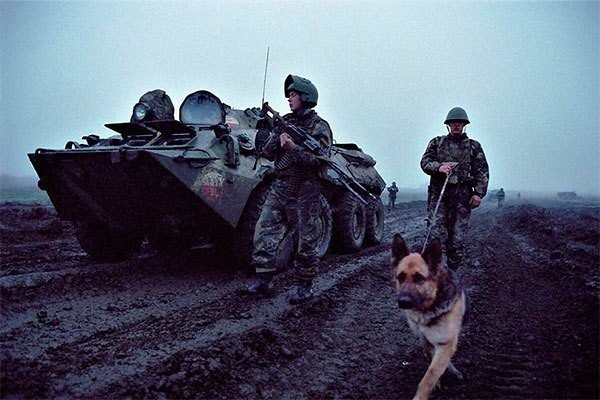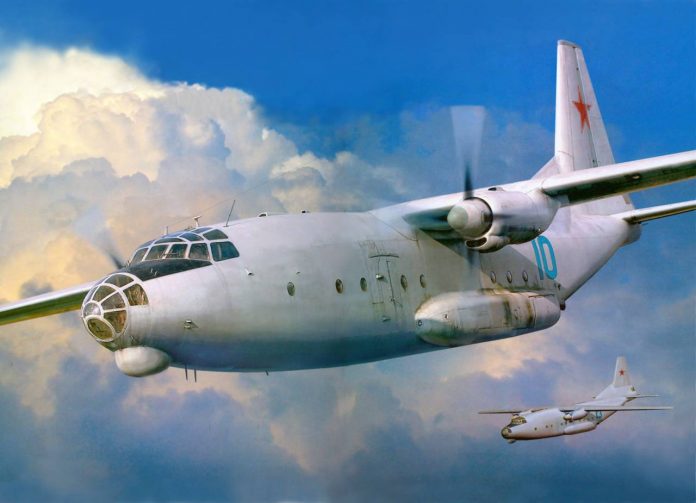
An-8 became the first aircraft, which in its capabilities approached the best overseas military transport aircraft. Developed in the 1950s, the aircraft became the first swallow of the updated Soviet military transport aviation (WTA).
Before the appearance of the An-8, transport aircraft that survived after the end of World War II were engaged in the transportation of military cargo in the interests of the Soviet Air Force. Li-2 (licensed copy of the American Douglas DC-3) and converted from passenger planes - IL-12D (troop-carrier) and The 14T (transport).
These planes, created in the second half of the 1940s, no longer met the requirements of the military, not keeping up with the rush of time. At the same time, the main geopolitical enemy of the Soviet Union massively exploited special transport aircraft variants - the C-119 Flying Boxcar, classic military transport C-123 Provider, and Lockheed has already begun work on one of the most famous and massive transport aircraft in the history of aviation - the C-130 Hercules. In the 1950s, the Lockheed C-130 Hercules four-engine turboprop was a new generation aircraft..
The history of the appearance of the An-8
IL-12D aircraft available for the Soviet Air Force, Il-12T and Il-14T were rework of passenger cars, which negatively affected their transport capabilities. Like the Li-2, they only had side doors., which were used for loading and unloading goods into the transport cabin.
At the same time, the American C-119 Flying Boxcar and C-123 Provider were specialized military transport aircraft.. Wide-body aircraft with reinforced floor structure for transporting heavy loads and rear-positioned double leaf transport doors, made it easy to place various artillery systems in the cargo compartment, mortars, cars and other military equipment. At the same time, on the C-123 Provider, the lower flap of the rear transport gate was folded down, also acting as a loading and unloading ramp.
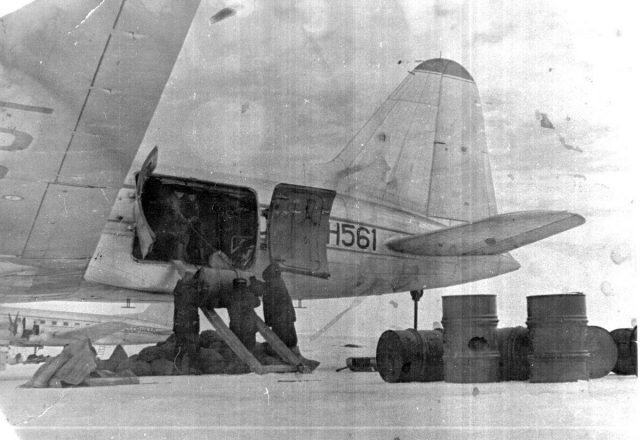 Loading process in IL-12D
Loading process in IL-12D
The accumulated post-war experience in the operation of military transport aviation, including during the Korean War (1950-1953 years), clearly demonstrated the request for a large transport aircraft, which could take off and land from field unpaved airfields, distinguished by increased carrying capacity and flight range. Such a car was necessarily equipped with several engines., but most importantly, the plane had to continue flying even in the event of a complete failure of one of the engines.
AT 1953 the year Soviet intelligence had information about the work of the Americans to create a new military transport aircraft, on which turboprop engines were installed (TVD). Dmitry Fedorovich Ustinov knew about the creation of "Hercules", who at that time served as Minister of Defense Industry of the Soviet Union. Together, this served as the impetus for the start of development work on the creation of the first Soviet specialized military transport aircraft with a theater of operation..
December 1953 year, a decree of the Council of Ministers of the USSR appears on the creation of a new transport aircraft in the Antonov Design Bureau, equipped with two turboprop engines. The transport and landing version of the future An-8 received a code - product "P", in parallel, work was underway on the project of the passenger version - product "N", but these works were stopped already in 1954 year, the creation of the passenger version was abandoned in favor of the new An-10 project.
The military made the following requirements for the future transport aircraft: transportation of anti-aircraft guns and field artillery systems of caliber up to 152 mm inclusive, transportation of 120-mm and 160-mm mortars, new wheeled armored personnel carriers BTR-40 and BTR-152, truck ZIL-157, all-wheel drive truck GAZ-63, at least two airborne self-propelled artillery mounts ASU-57 and other military equipment. Also, the Ministry of Defense expected, that the new plane can take on board at least 40 a soldier with his weapons or the same number of paratroopers.
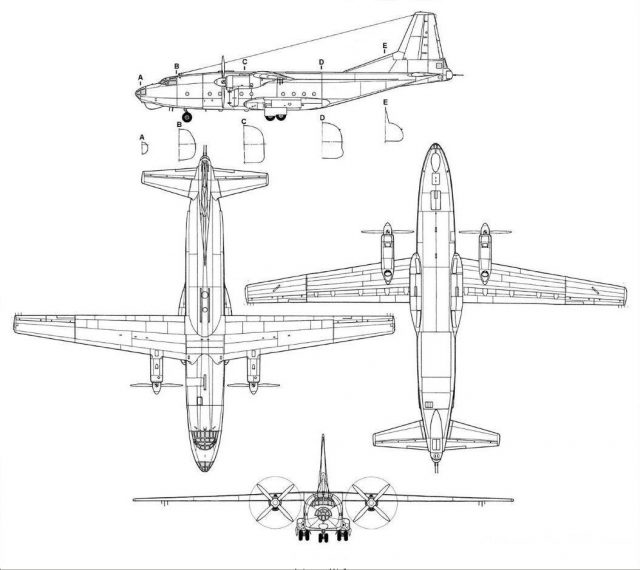 Scheme of the An-8 aircraft
Scheme of the An-8 aircraft
In fact, a new Soviet military transport aircraft was being developed, to close the emerging gap with the United States in the field of military air cargo transportation. The transport aircraft created at the Antonov Design Bureau had to meet the following requirements:
- the ability to take off and land from unpaved airfields of short length;
- the ability to fly in adverse weather conditions and at any time of the day or night;
- the presence of a spacious cargo compartment and a wide cargo hatch, located in the rear of the aircraft.
The design bureau was supposed to create a new car for the country from scratch., who at that time did not have sufficient experience and skills in this area. That is why the chief designer Oleg Konstantinovich Antonov turned to colleagues from the Ilyushin Design Bureau and Tupolev Design Bureau for help with a request to send design documentation and drawings for the Il-28 and Tu-16 aircraft to Kiev..
In addition, groups of engineers went from the Antonov Design Bureau to aviation plants in Moscow and Kazan, to study the indicated aircraft on the spot. Oleg Konstantinovich also turned to aircraft designer Robert Ludwigovich Bartini for help., who helped with the floor drawings of the cargo compartment of the future military transport aircraft. Antonov Design Bureau was able to implement Bartini's project, making changes to it.
It is worth noting, that the cargo compartment floor is an important part of any military transport aircraft. The floor is made reinforced and durable, to withstand the heavy weight of transported military equipment and cargo for various purposes, in addition, it acts as an additional protection for the aircraft in the event of an emergency landing.
On the An-8, the very idea of the cabin floor construction was of great interest - the longitudinal beams of the truss structure were passed through the frames. Thanks to this solution, the designers have achieved that, that the floor of the cargo compartment is strong and light at the same time, no claims were ever made against the aircraft after the start of operation. All the experience gained in other design bureaus helped Antonov and his designers avoid a large number of mistakes at the design stage, which made it possible to create a new military transport aircraft in a short time.
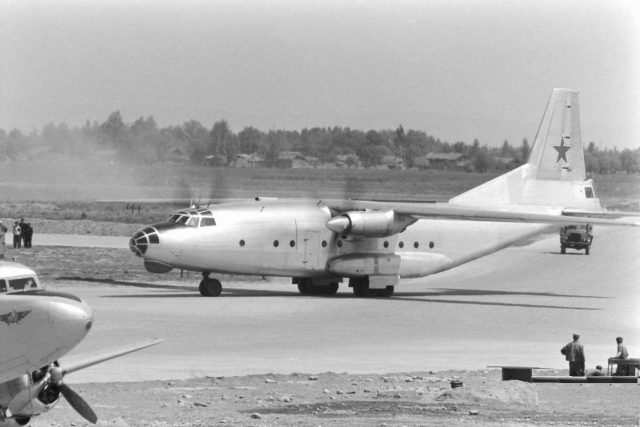 An-8 on taxiing
An-8 on taxiing
The first rollout of a new aircraft, which has already received the official name An-8, took place in February 1956 of the year. The Antonov Design Bureau timed this event to the 50th anniversary of the talented chief designer. 11 February, a new transporter took to the skies for the first time. Despite a malfunction in the flap control system during flight, the plane successfully completed its first flight, flying from the Svyatoshino airfield to Boryspil, where the full range of factory tests of the new machine began.
In the same 1956 the aircraft was first shown to the general public. The debut of the new car fell on the traditional aviation parade in Tushino, where citizens saw another novelty of the Soviet aviation industry - the first jet passenger aircraft Tu-104. State tests of An-8 ended at the end 1959 of the year, at the same time the plane was officially adopted by the Military Transport Aviation.
Design features of the An-8 aircraft
Lots 8, like their American counterparts - the C-123 and C-130 transport aircraft - it was an all-metal high-winged plane. The first An-8 was superior due to modern turboprop engines, на C-123 Provider, which made its first flight back in 1949 year, two piston engines were installed. But the C-130 was a larger aircraft., which, with a similar layout and appearance, was a much more cargo-carrying aircraft.
The maximum takeoff weight of the An-8 did not exceed 41 tons, and the Lockheed C-130 Hercules reached 70 tonnes. In addition, the power plant of the "American" included four turboprop engines. Closest to "Hercules", which took off two years earlier than An-8, was a Soviet military transport aircraft An-12, characterized by similar transport capabilities and the presence of four theaters.
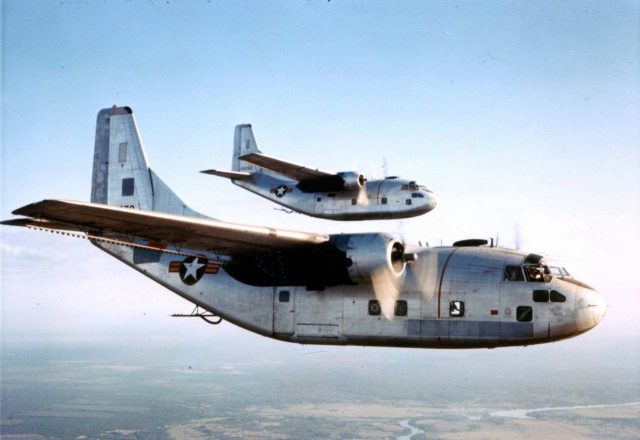 C-123 Provider in flight
C-123 Provider in flight
The serial production of a new transport aircraft was entrusted to the Tashkent Aviation Plant, on which the Il-14 planes were assembled before. At the same time, the An-8 differed in design from its predecessor assembled in Tashkent in a fundamental way..
To release a new transport vehicle at the plant, it was necessary to expand the production facilities of the assembly shops, and 1957 a new workshop was opened especially for the production of An-8 aircraft, designed for the production of long and large parts. In addition, the workers had to master new technological processes., for example forging and stamping large-sized parts, which employees of the enterprise have not encountered before.
The main distinguishing features of the An-8 design from its predecessors were three things:
— transport cabin with large cargo hatch, located in the rear of the aircraft;
— new turboprop engines;
— availability of a modern radar sight RBP-3.
Together, this brought the first Soviet specialized transport aircraft to a new level., allowing you to compete with planes, which in the same years entered service with the American Air Force.
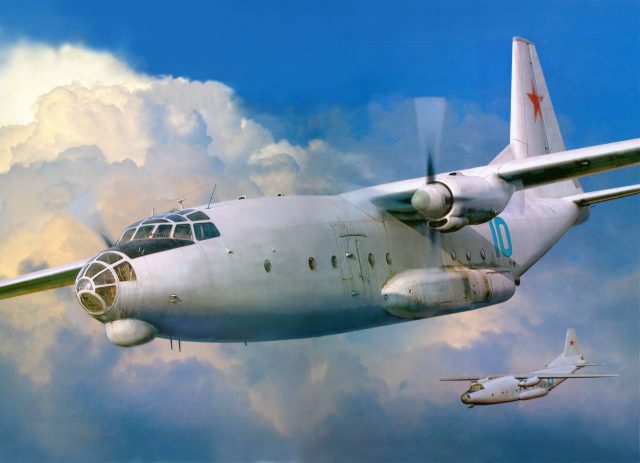
The presence of a large hatch in the rear of the aircraft greatly facilitated the process of loading and unloading military equipment and cargo.. Compared to Li-2, Il-12 and Il-14 - it was a real breakthrough. Now the plane could carry various military equipment in the cargo hold, which drove aboard the An-8 on its own through special cargo ramps (carried on board the aircraft) or non-self-propelled, when the cable system and electric winches were used.
New AI-20D single-shaft forced aircraft turboprop engines deliver maximum power 5180 HP. This was enough, to accelerate the plane to 520 kmh, cruising speed was 450 kmh. According to these indicators, the An-8 was superior to the lighter twin-engine C-123 Provider. (with weaker piston engines, full speed 398 kmh), but predictably lost to the heavy four-engine C-130 Hercules (maximum speed up to 590 kmh).
In terms of carrying capacity, the new Soviet transport aircraft was in the middle between its American peers. An-8 took on board the maximum load of about 11 tonnes, "Hercules" transported up to 20 tons of cargo, and C-123 Provider - a little less than seven tons.
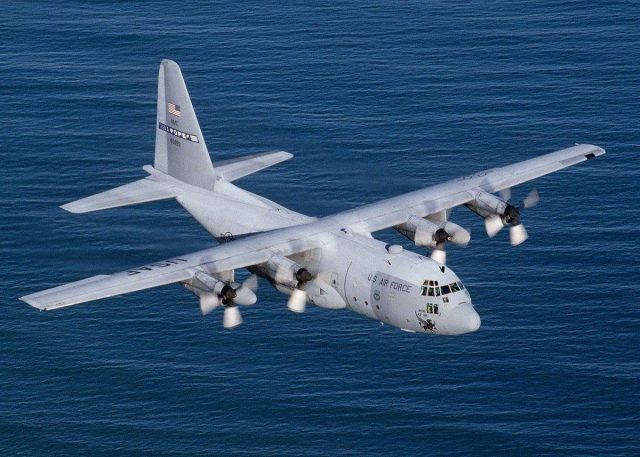 Lockheed C-130E Hercules
Lockheed C-130E Hercules
To the features of the machine, which distinguished the An-8 from Soviet transport aircraft of past years, treated radar sight, which allowed the crew to locate the transporter, drift angle, flight speed and wind strength. The RBP-3 sight installed on the aircraft made it possible to detect a large industrial center at a distance of up to 80-120 km (when flying at altitude 5-8 thousand meters). For example, marks of cities such as Ivanovo, Yaroslavl appeared on radar in the cockpit for 80-110 km, and large bodies of water - for 80 km.
The fate of the An-8
For four years of serial production with 1958 of the year (built the first 10 aircraft) by 1961 year inclusive in the USSR collected 151 An-8 aircraft. In the part of military transport aviation, the aircraft began to arrive in 1959 year and remained in service until 1970 of the year. The surviving aircraft were transferred to other units of the armed forces and various ministries.
Some of the aircraft continued to operate after the collapse of the USSR., the plane worked in private companies, engaged in commercial cargo transportation in Africa and the Middle East.
An-8 became the first aircraft in the line of Soviet military transport aircraft, created in the Antonov Design Bureau. In parallel with it, a more capacious four-engine An-12 transport aircraft was created., and then even larger military-technical cooperation followed -
An-22, AN-124 and AN-225, which can be safely attributed to man-made air whales. The An-26 multipurpose transport aircraft was also extremely successful., which could not boast of such dimensions and carrying capacity, but to this day he serves faithfully in the armies of many countries of the world, including Russian.
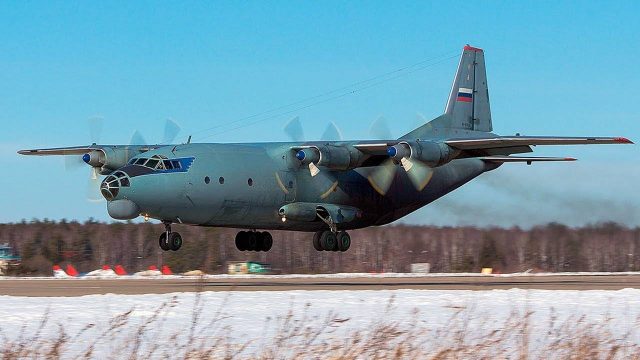 Military transport aircraft An-12
Military transport aircraft An-12
The An-8 military transport aircraft seriously influenced the fate of the An-8 serial production, which the Soviet industry mastered in 1958 year, and the troops began to receive a new vehicle in parallel with the An-8. The larger An-12 received four AI-20M turboprop engines, during operation, its permitted take-off weight increased to 61 tons, and the maximum load twice exceeded the capabilities of the An-8.
The designers considered, that planes can be produced in parallel, and An-8 will occupy a niche for the transportation of medium-sized military cargo (it was the most rational decision), but the military and top leadership of the country made a decision, different from the opinions of Oleg Konstantinovich Antonov and the Minister of Aviation Industry of the USSR Peter Vasilyevich Dementyev, leaving only An-12 in the shops of aviation plants.
By the way, An-12 turned out to be a worthy competitor for its overseas counterpart C-130, not inferior to the American even in terms of production: only in the Soviet Union was it collected 1248 aircraft of this type.
/Sergey Yuferev, topwar.ru/







